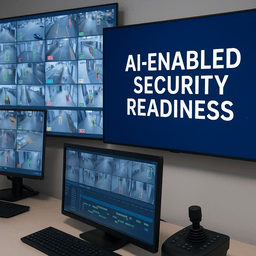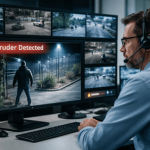
AI is no longer a buzzword—it’s here, and it’s changing the way security systems operate.
From real-time video analytics to automated threat detection, AI-enabled security systems are already helping organizations move from reactive to proactive protection. But here’s the catch: not every system is ready for AI. In fact, trying to layer AI onto outdated infrastructure can be frustrating, expensive, and ineffective.
At SSP, we help clients assess their AI readiness before making the leap. If you’re wondering whether your current system can support the latest tech—or what you need to get there—this article is for you.
k
k
🤖 What Is an AI-Enabled Security System?
AI-enabled security uses machine learning algorithms to analyze data, recognize patterns, and make decisions that would otherwise require human input. It’s often used to:
-
Detect unusual behavior on surveillance cameras
-
Identify objects (vehicles, people, license plates)
-
Reduce false alarms by filtering out non-threats
-
Automate access decisions based on activity patterns
-
Alert security teams only when action is actually needed
In short: AI helps your system work smarter, not harder.
k
k
✅ What Are the Benefits of AI-Enabled Security?
-
Fewer false alarms = less alert fatigue
-
Faster response times to actual threats
-
More efficient staffing for security teams
-
Better evidence for investigations and audits
-
24/7 learning—systems get more accurate over time
AI doesn’t replace human security—it amplifies it.
k
k
🛠️ Is Your System Ready? Here’s What You Need
Before you dive into an upgrade, let’s break down what an AI-ready security system actually needs:
1. IP-Based Cameras (Not Analog)
AI video analytics can only work with digital video feeds that send high-quality, streamable footage.
If you're still running analog CCTV, it’s time to:
-
Upgrade to IP cameras
-
Check that your network can handle the bandwidth
-
Choose models that support motion analytics and wide dynamic range
k
k
2. Cloud or Edge Processing Capability
AI requires processing power—and lots of it. That happens either:
-
In the cloud (for centralized management and remote access)
-
At the edge (on the device itself or via local NVRs with AI chips)
You'll want to work with a system that:
-
Integrates with cloud-based AI platforms
-
Or supports on-site analytics with built-in AI features
k
k
3. Sufficient Storage and Bandwidth
AI doesn’t just analyze video—it often stores, tags, and indexes events for future review.
Make sure you have:
-
Enough storage (cloud or on-prem) for higher-resolution footage
-
Network bandwidth to support streaming multiple high-def feeds
-
Retention policies that align with your compliance needs
k
k
4. Open API Compatibility
Want your AI system to talk to access control, alarms, or other systems? You’ll need:
-
A platform that supports open APIs
-
Integration with third-party AI services or video analytics platforms
-
A vendor that plays well with others (not all do)
This ensures your security ecosystem grows with you—not against you.
k
k
5. A Human-Centric Policy for Alerts and Action
Technology is only as good as the people using it.
Before enabling AI, consider:
-
Who will respond to AI-generated alerts?
-
How are alerts prioritized or filtered?
-
Will staff be trained to understand what the system is telling them?
Without human understanding and protocols, AI will just become background noise.
k
k
🧠 Common Misconceptions About AI in Security
“AI is only for large enterprise security.”
→ Not true. Cloud-based AI is becoming accessible to mid-sized clinics, schools, and warehouses.
“AI replaces human judgment.”
→ Wrong. It supports human teams by surfacing only what matters.
“AI is too expensive.”
→ While upfront costs vary, AI actually reduces long-term labor and false-alarm costs.
k
k
🚦How to Get Started with AI-Enabled Security
Here’s a basic roadmap:
-
Audit your existing infrastructure (cameras, storage, network, policies)
-
Identify your primary goals (reduce false alarms? automate alerts?)
-
Talk to your integrator (hi, SSP 👋) about what AI tools match your goals
-
Run a pilot on one camera, zone, or door before scaling
-
Train your team on what to expect—and how to respond
j
j
Final Thoughts: AI Isn’t the Future—It’s the Now
AI can’t stop threats on its own. But it helps your system see patterns, reduce noise, and act faster—giving your team the tools they need to make smarter decisions in real time.
At SSP, we help clients integrate AI the right way—without overcomplicating it or overspending. If your security strategy is ready for the next step, we’ll make sure your system is, too.


